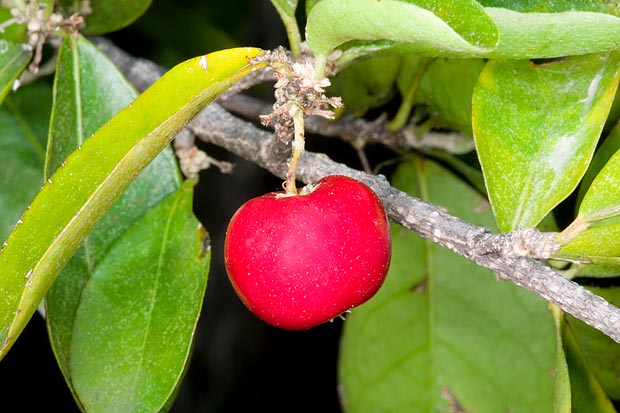Family Malpighiaceae

Text © Pietro Puccio

English translation by Mario Beltramini

Malpighia glabra is a 3-5 m shrub with 1-2 cm, very rich in vitamin C, fruits © Giuseppe Mazza
The genus is honoured to the Italian physician and physiologist Marcello Malpighi (1628-1694); the name of the species comes from the Latin adjective “glaber” = glabrous, smooth, with reference to the smooth foliar surface.
Common names: acerola, Antilles cherry, Barbados-cherry, West-Indian-cherry, wild crape-myrtle (English); cerisier, cerise de St. Domingue (French); cerejeira (Portuguese); acerola, careza, careza colorada, escobillo, grosella (Spanish).
The Malpighia glabra L. (1753) is a shrub or a small semi-deciduous, 3-5 m tall, tree, with a trunk of 10 cm of diameter with a grey-brown bark. The leaves are opposite, simple with entire margin, ovate-lanceolate, 2-8 cm long and about 2 cm broad, of dark green colour on the upper page, initially covered by a grey tomentum below.
The flowers are grouped, in number of 3 to 7, in axillar umbrellas and have 5 roundish petals, getting thinner at the base, pink and with undulated margins, about 6 mm long.
The fruit is a globular drupe, with three more or less outlined lobes, of 1-2 cm of diameter, which ripens after about 3 weeks from the flowering becoming from green to red, then yellowish red, with juicy orange pulp containing three tiny seeds; the taste is sour or acidulous, but there are varieties with a fairly sweet taste.
It reproduces by seed and quite easily by cutting in a sandy soil kept humid; the plants may begin to fructify, from the seed, after two, three years, from the cutting even after one year.
It is a well known species due to the high contents of ascorbic acid (vitamin C), 1,5-3,5 % in weight, of its fruits, which are utilized industrially for the juice that is added to several drinks in order to increase its contents; for this purpose, the fruits is harvested when still green, when the presence of the vitamin C is maximum. The fruit contains also vitamin A and B, flavonoids, carotenoids and minerals.
Locally, besides the juice, its fruits are consumed also fresh, in such case they are conserved for not more than two, three days, being rapidly perishable, or utilized for preparing preserves and jams.
Being a species suitable for tropical and subtropical climates, the young plants die already with temperatures of -1 °C, in the adult plants, the foliage gets damaged around the -3 °C, the foot of the plant is believed to resist to -5 °C.
The best exposure is in full sun; it may stand also a slight shade, but in this case it fructifies less. It is not particular for what the soil is concerned as it can grow up indifferently in the rocky, sandy or clayey, neutral or alkaline, soils, provided well drained as it does not stand water stagnations which may prove deadly.
Its blooming is related to the availability of water, if this one is not missing, the blooming may last from spring to autumn; in any case, it may bear, if well rooted, long dryness periods, but in such case it will not bloom and might even get to lose the leaves.
It is also utilized as ornamental plant, or isolated specimen, or finally, for hedges and borders, as it stands the pruning; the watering must be regular in summer in the warm and dry climates.
Synonyms: Malpighia punicifolia L. (1762); Malpighia nitida Mill. (1768); Malpighia biflora Poir. (1787); Malpighia fallax Salisb. (1796); Malpighia lucida Pav. ex A. Juss. (1840); Malpighia semeruco A.Juss. (1840); Malpighia lucida Pav. ex Moric. (1841); Malpighia peruviana Moric. (1841); Malpighia undulata A. Juss. (1843); Malpighia neumanniana A. Juss. (1846); Bunchosia parvifolia S.Watson (1889); Malpighia myrtoides Moritz ex Nied. (1928).
→ To appreciate the biodiversity within MALPIGHIACEAE family please click here.
